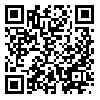Volume 26, Issue 1 (April 2019)
J Birjand Univ Med Sci. 2019, 26(1): 54-63 |
Back to browse issues page
Download citation:
BibTeX | RIS | EndNote | Medlars | ProCite | Reference Manager | RefWorks
Send citation to:



BibTeX | RIS | EndNote | Medlars | ProCite | Reference Manager | RefWorks
Send citation to:
Mirhoseini F, Tabrizizadeh M, Falah-yakhdani A, Ansarinia A, Sadoughi M. Comparison of the diagnostic accuracy of different image processing algorithms in the diagnosis of jawbone defects. J Birjand Univ Med Sci. 2019; 26 (1) :54-63
URL: http://journal.bums.ac.ir/article-1-2535-en.html
URL: http://journal.bums.ac.ir/article-1-2535-en.html
Farzaneh Mirhoseini1  , Mahdi Tabrizizadeh2
, Mahdi Tabrizizadeh2  , Azadeh Falah-yakhdani3
, Azadeh Falah-yakhdani3  , Amin Ansarinia4
, Amin Ansarinia4  , Monireh Sadoughi *
, Monireh Sadoughi *  5
5
 , Mahdi Tabrizizadeh2
, Mahdi Tabrizizadeh2  , Azadeh Falah-yakhdani3
, Azadeh Falah-yakhdani3  , Amin Ansarinia4
, Amin Ansarinia4  , Monireh Sadoughi *
, Monireh Sadoughi *  5
5
1- Department of Oral and Maxillofacial Radiology, School of Dentistry, Shahid Sadoughi University of Medical Sciences, Yazd, Iran
2- Department of Endodontics, School of Dentistry, Shahid Sadoughi University of Medical Sciences, Yazd, Iran Private Practice, Yazd, Iran
3- General Dentist, Yazd, Iran.
4- School of Dentistry, Shahid Sadoughi University of Medical Sciences, Yazd, Iran
5- Department of Operative Dentistry, School of Dentistry, Shahid Sadoughi University of Medical Sciences, Private Practice, Yazd, Iran , sadoughi_monireh@yahoo.com
2- Department of Endodontics, School of Dentistry, Shahid Sadoughi University of Medical Sciences, Yazd, Iran Private Practice, Yazd, Iran
3- General Dentist, Yazd, Iran.
4- School of Dentistry, Shahid Sadoughi University of Medical Sciences, Yazd, Iran
5- Department of Operative Dentistry, School of Dentistry, Shahid Sadoughi University of Medical Sciences, Private Practice, Yazd, Iran , sadoughi_monireh@yahoo.com
Abstract: (7006 Views)
Background and Aim: Intra-bone lesions are common in lesions, among them periapical lesions have a higher incidence. Todays, all direct digital imaging systems provide various types of image processing techniques. The purpose of this study is to investigate the effects of different digital image processing techniques on the diagnosis of bony defects.
Materials and Methods: In this experimental study, 50 sheep inferior half-jawbones were used. Lesions were created by round bars with numbers 1/4, 1/2, 1, 2 and 4. Digital images were obtained by edge enhance, sharpening, invert gray scale processing method and unprocessed investigated by two radiologists and in case of disagreement them observers by third observer. The method of recording the results was definitive diagnosis of lesion number 1, misdiagnosis number 2 and possible diagnosis number 3 .The results were analyzed by chi-square and Fisher's exact tests.
Results: Percent of diagnostic sensitivity in unprocessed Images (71.8%) and images processed with Sharpen filter (71.4%) were significantly higher than images processed with invert grayscale (68.5%) and edge Enhancer (53%).(p<0.001)
Conclusion: To detect bone lesions, unprocessed and processed digital images with Sharpen filters have higher diagnostic accuracy.
Materials and Methods: In this experimental study, 50 sheep inferior half-jawbones were used. Lesions were created by round bars with numbers 1/4, 1/2, 1, 2 and 4. Digital images were obtained by edge enhance, sharpening, invert gray scale processing method and unprocessed investigated by two radiologists and in case of disagreement them observers by third observer. The method of recording the results was definitive diagnosis of lesion number 1, misdiagnosis number 2 and possible diagnosis number 3 .The results were analyzed by chi-square and Fisher's exact tests.
Results: Percent of diagnostic sensitivity in unprocessed Images (71.8%) and images processed with Sharpen filter (71.4%) were significantly higher than images processed with invert grayscale (68.5%) and edge Enhancer (53%).(p<0.001)
Conclusion: To detect bone lesions, unprocessed and processed digital images with Sharpen filters have higher diagnostic accuracy.
Type of Study: Original Article |
Subject:
Dentistry
Received: 2018/07/11 | Accepted: 2018/12/11 | ePublished: 2019/03/17
Received: 2018/07/11 | Accepted: 2018/12/11 | ePublished: 2019/03/17
Send email to the article author
| Rights and permissions | |
 |
This work is licensed under a Creative Commons Attribution-NonCommercial 4.0 International License. |





